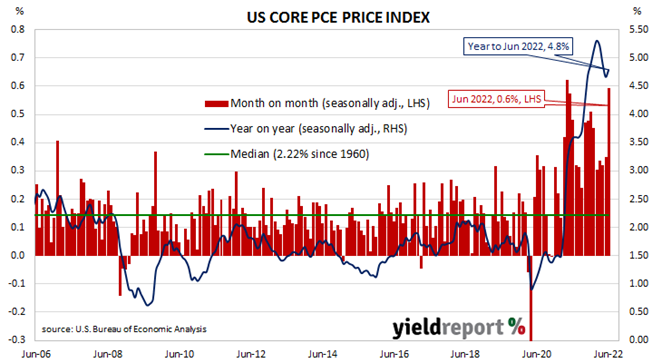Summary: US core PCE price index up 0.6% in June, more than expected; annual rate ticks up from 4.7% to 4.8%; normalising of inflation pressures in doubt after report; long-term Treasury yields down modestly; rate rises still expected.
One of the US Fed’s favoured measures of inflation is the change in the core personal consumption expenditures (PCE) price index. After hitting the Fed’s target at the time of 2.0% in mid-2018, the annual rate then hovered in a range between 1.8% and 2.0% before it eased back to a range between 1.5% and 1.8% through 2019. It then plummeted below 1.0% in April 2020 before rising back to around 1.5% in the September quarter of that year. It has since increased significantly above the Fed’s target.
The latest figures have now been published by the Bureau of Economic Analysis as part of the June personal income and expenditures report. Core PCE prices rose by 0.6% over the month, slightly more than the 0.5% which had been generally expected but double May’s 0.3% increase. On a 12-month basis, the core PCE inflation rate ticked up from May’s figure of 4.7% to 4.8%.
ANZ senior economist Adelaide Timbrell said the figures places doubt on “the notion that inflation pressures are on the brink of normalising completely.”
Long-term US Treasury bond yields declined modestly on the day. By the close of business, 10-year and 30-year Treasury bond yield had both lost 2bps to 2.65% and 3.01% respectively. The 2-year yield finished 2bps higher at 2.88%.
In terms of US Fed policy, expectations of a higher federal funds rate over the next 12 months softened, particularly with respect to 2023. At the close of business, September contracts implied an effective federal funds rate of 2.505%, 18bps higher than the current spot rate while November contracts implied a rate of 3.155%. July 2023 futures contracts implied 3.02%, 69bps above the spot rate.
The core version of PCE strips out energy and food components, which are volatile from month to month, in an attempt to identify the prevailing trend. It is not the only measure of inflation used by the Fed; the Fed also tracks the Consumer Price Index (CPI) and the Producer Price Index (PPI) from the Department of Labor. However, it is the one measure which is most often referred to in FOMC minutes.


